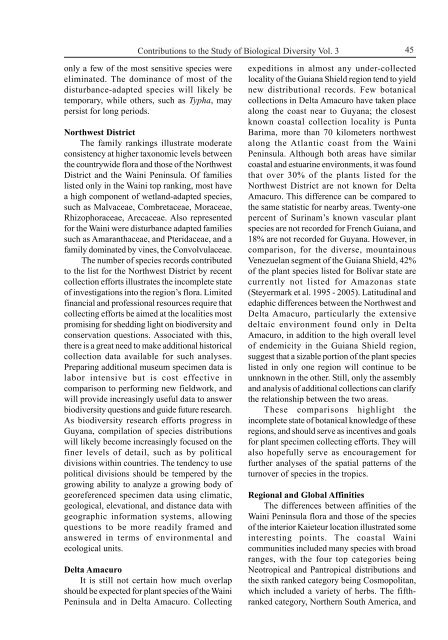Plant Community Structure, Fire Disturbance, and Recovery in ...
Plant Community Structure, Fire Disturbance, and Recovery in ...
Plant Community Structure, Fire Disturbance, and Recovery in ...
Create successful ePaper yourself
Turn your PDF publications into a flip-book with our unique Google optimized e-Paper software.
Contributions to the Study of Biological Diversity Vol. 3<br />
only a few of the most sensitive species were<br />
elim<strong>in</strong>ated. The dom<strong>in</strong>ance of most of the<br />
disturbance-adapted species will likely be<br />
temporary, while others, such as Typha, may<br />
persist for long periods.<br />
Northwest District<br />
The family rank<strong>in</strong>gs illustrate moderate<br />
consistency at higher taxonomic levels between<br />
the countrywide flora <strong>and</strong> those of the Northwest<br />
District <strong>and</strong> the Wa<strong>in</strong>i Pen<strong>in</strong>sula. Of families<br />
listed only <strong>in</strong> the Wa<strong>in</strong>i top rank<strong>in</strong>g, most have<br />
a high component of wetl<strong>and</strong>-adapted species,<br />
such as Malvaceae, Combretaceae, Moraceae,<br />
Rhizophoraceae, Arecaceae. Also represented<br />
for the Wa<strong>in</strong>i were disturbance adapted families<br />
such as Amaranthaceae, <strong>and</strong> Pteridaceae, <strong>and</strong> a<br />
family dom<strong>in</strong>ated by v<strong>in</strong>es, the Convolvulaceae.<br />
The number of species records contributed<br />
to the list for the Northwest District by recent<br />
collection efforts illustrates the <strong>in</strong>complete state<br />
of <strong>in</strong>vestigations <strong>in</strong>to the region’s flora. Limited<br />
f<strong>in</strong>ancial <strong>and</strong> professional resources require that<br />
collect<strong>in</strong>g efforts be aimed at the localities most<br />
promis<strong>in</strong>g for shedd<strong>in</strong>g light on biodiversity <strong>and</strong><br />
conservation questions. Associated with this,<br />
there is a great need to make additional historical<br />
collection data available for such analyses.<br />
Prepar<strong>in</strong>g additional museum specimen data is<br />
labor <strong>in</strong>tensive but is cost effective <strong>in</strong><br />
comparison to perform<strong>in</strong>g new fieldwork, <strong>and</strong><br />
will provide <strong>in</strong>creas<strong>in</strong>gly useful data to answer<br />
biodiversity questions <strong>and</strong> guide future research.<br />
As biodiversity research efforts progress <strong>in</strong><br />
Guyana, compilation of species distributions<br />
will likely become <strong>in</strong>creas<strong>in</strong>gly focused on the<br />
f<strong>in</strong>er levels of detail, such as by political<br />
divisions with<strong>in</strong> countries. The tendency to use<br />
political divisions should be tempered by the<br />
grow<strong>in</strong>g ability to analyze a grow<strong>in</strong>g body of<br />
georeferenced specimen data us<strong>in</strong>g climatic,<br />
geological, elevational, <strong>and</strong> distance data with<br />
geographic <strong>in</strong>formation systems, allow<strong>in</strong>g<br />
questions to be more readily framed <strong>and</strong><br />
answered <strong>in</strong> terms of environmental <strong>and</strong><br />
ecological units.<br />
Delta Amacuro<br />
It is still not certa<strong>in</strong> how much overlap<br />
should be expected for plant species of the Wa<strong>in</strong>i<br />
Pen<strong>in</strong>sula <strong>and</strong> <strong>in</strong> Delta Amacuro. Collect<strong>in</strong>g<br />
45<br />
expeditions <strong>in</strong> almost any under-collected<br />
locality of the Guiana Shield region tend to yield<br />
new distributional records. Few botanical<br />
collections <strong>in</strong> Delta Amacuro have taken place<br />
along the coast near to Guyana; the closest<br />
known coastal collection locality is Punta<br />
Barima, more than 70 kilometers northwest<br />
along the Atlantic coast from the Wa<strong>in</strong>i<br />
Pen<strong>in</strong>sula. Although both areas have similar<br />
coastal <strong>and</strong> estuar<strong>in</strong>e environments, it was found<br />
that over 30% of the plants listed for the<br />
Northwest District are not known for Delta<br />
Amacuro. This difference can be compared to<br />
the same statistic for nearby areas. Twenty-one<br />
percent of Sur<strong>in</strong>am’s known vascular plant<br />
species are not recorded for French Guiana, <strong>and</strong><br />
18% are not recorded for Guyana. However, <strong>in</strong><br />
comparison, for the diverse, mounta<strong>in</strong>ous<br />
Venezuelan segment of the Guiana Shield, 42%<br />
of the plant species listed for Bolívar state are<br />
currently not listed for Amazonas state<br />
(Steyermark et al. 1995 - 2005). Latitud<strong>in</strong>al <strong>and</strong><br />
edaphic differences between the Northwest <strong>and</strong><br />
Delta Amacuro, particularly the extensive<br />
deltaic environment found only <strong>in</strong> Delta<br />
Amacuro, <strong>in</strong> addition to the high overall level<br />
of endemicity <strong>in</strong> the Guiana Shield region,<br />
suggest that a sizable portion of the plant species<br />
listed <strong>in</strong> only one region will cont<strong>in</strong>ue to be<br />
unnknown <strong>in</strong> the other. Still, only the assembly<br />
<strong>and</strong> analysis of additional collections can clarify<br />
the relationship between the two areas.<br />
These comparisons highlight the<br />
<strong>in</strong>complete state of botanical knowledge of these<br />
regions, <strong>and</strong> should serve as <strong>in</strong>centives <strong>and</strong> goals<br />
for plant specimen collect<strong>in</strong>g efforts. They will<br />
also hopefully serve as encouragement for<br />
further analyses of the spatial patterns of the<br />
turnover of species <strong>in</strong> the tropics.<br />
Regional <strong>and</strong> Global Aff<strong>in</strong>ities<br />
The differences between aff<strong>in</strong>ities of the<br />
Wa<strong>in</strong>i Pen<strong>in</strong>sula flora <strong>and</strong> those of the species<br />
of the <strong>in</strong>terior Kaieteur location illustrated some<br />
<strong>in</strong>terest<strong>in</strong>g po<strong>in</strong>ts. The coastal Wa<strong>in</strong>i<br />
communities <strong>in</strong>cluded many species with broad<br />
ranges, with the four top categories be<strong>in</strong>g<br />
Neotropical <strong>and</strong> Pantropical distributions <strong>and</strong><br />
the sixth ranked category be<strong>in</strong>g Cosmopolitan,<br />
which <strong>in</strong>cluded a variety of herbs. The fifthranked<br />
category, Northern South America, <strong>and</strong>
















